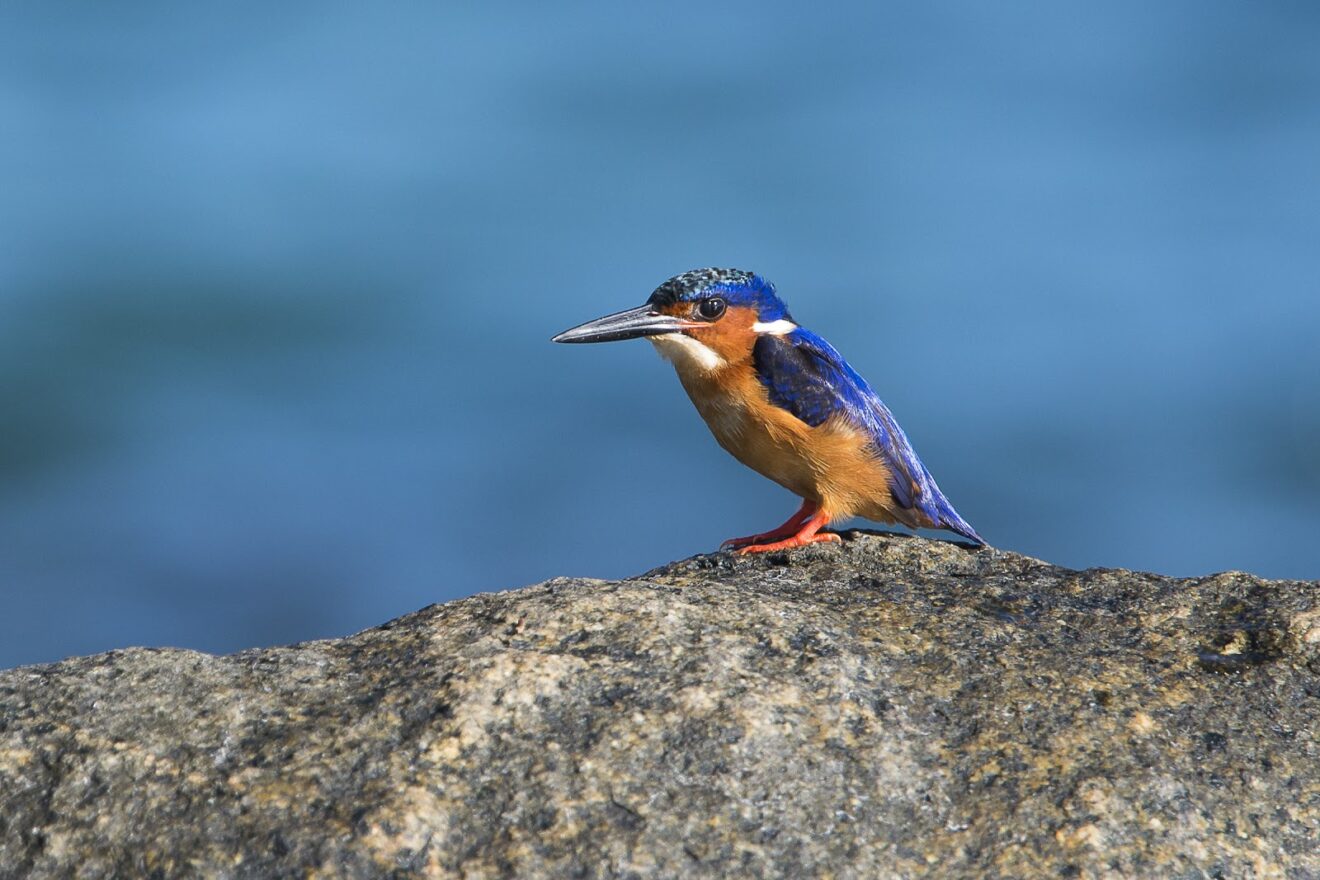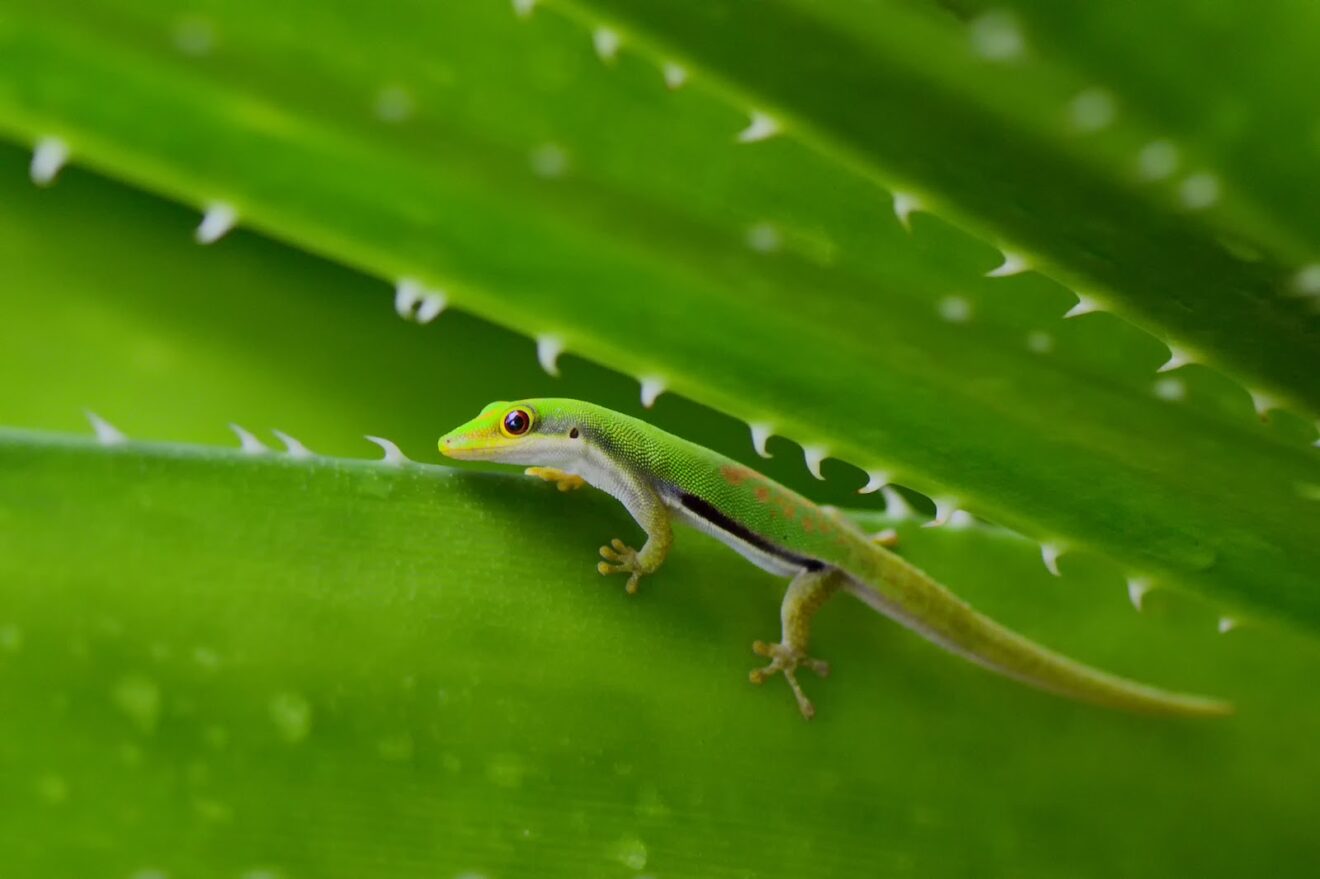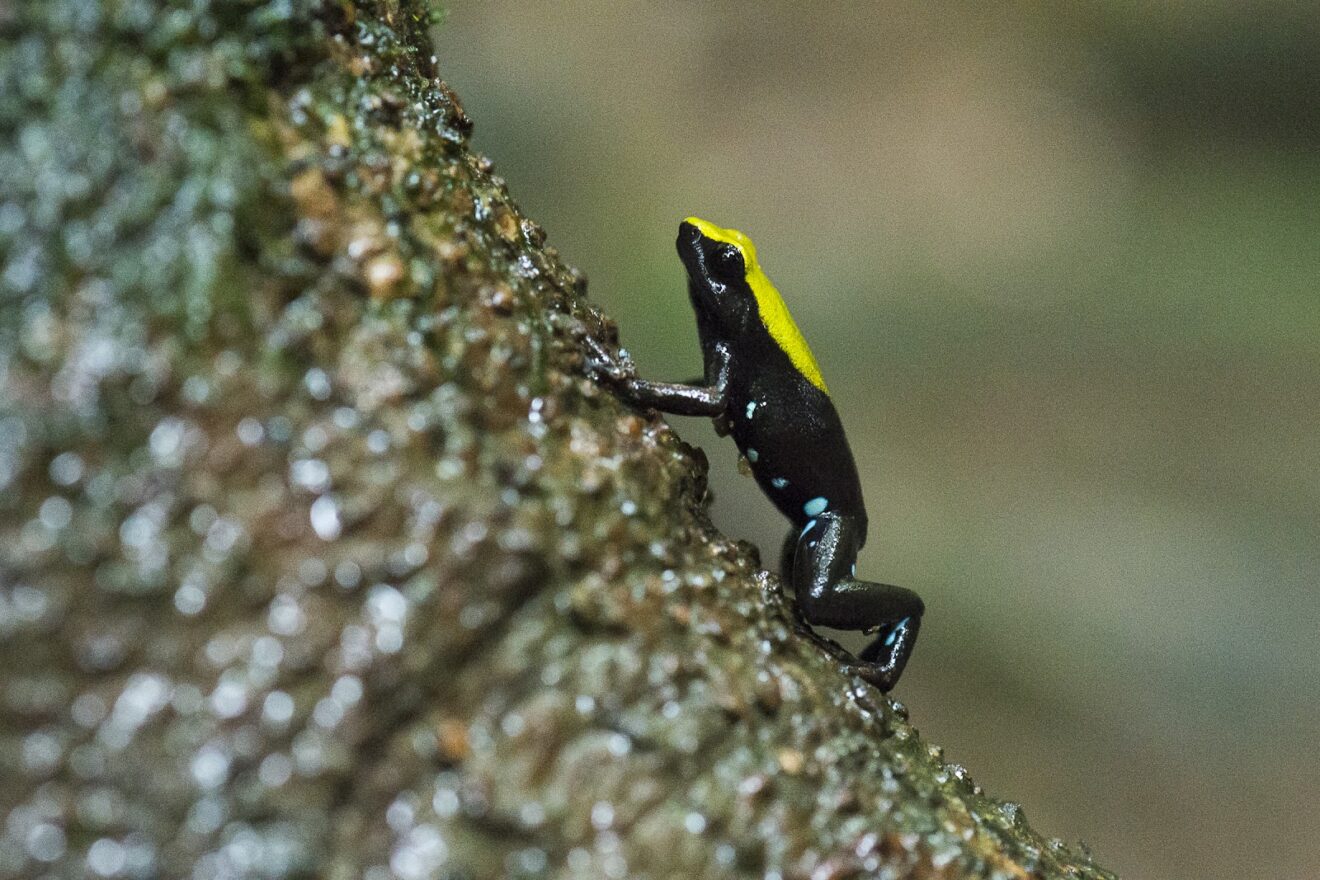The forests around Antongil Bay, including the Masoala peninsula to the east, harbor fifty percent or more of the terrestrial biological diversity of Madagascar. Madagascar as a whole is renowned as one of the top three hotspots of biodiversity in the world. With some two percent of all the life forms on our entire planet, it is no exaggeration to state that Masoala and the broad Antongil Bay landscape are among the highest conservation priorities in the world. A glance at the map of Africa and Madagascar reveals the curious mirror images of the great red island’s west coast and the east coast of Mozambique. Scientists debate the exact history of the island’s origine, but the general consensus is that Madagascar broke away from the ancient landmass Gondwanaland 140 – 200 million years ago and drifted eastward. At some later time, probably about 88 million years ago, India split from Madagascar and continued its geologically rapid journey into the northern hemisphere.




The assemblage of animals and plants found on Madagascar today reflect its Gondwanaland origins. The island’s long isolation has separated it from species that evolved on the African mainland and allowed unique forms of life to evolve. Some ancient groups such as the boas, snakes that are otherwise only found in South America, have survived on Madagascar since the time of Gondwanaland, while in Africa and Asia the pythons later replaced them. The presence and absence of other animal groups is more difficult to explain. The lemures, the primitive primates for which Madagascar is perhaps best-known, originated about 62 million years ago, long after the island’s separation from both Africa and India. But fossil lemurs have been found in both Africa and Pakistan and so it is assumed that lemurs must have reached Madagascar somehow after it became an island. How they got there remains a mystery. Possibly they drifted out from the African mainland huge floating mats of vegetation. For some reason, no large carnivores managed to make the same journey. Whilst many such puzzles remain, it is clear that Madagascar’s isolation has left it with an extraordinary diversity of species and even families of animals and plants that are totally unique. Not surprisingly, this high level of uniqueness, or endemism, is most striking to the species that do not fly. While almost all the native reptiles, amphibians, freshwater fish, insects and trees are endemic, many of the bats and the birds are also found on the African mainland.

Just as the physical boundaries of sea and land had a vast impact on the types of animals that occur in Madagascar, physical boundaries within the country have also had a huge effect on patterns of animal distribution. The lemurs are the most-studied group of animals and show clearly the effects of these physical barriers. Many lemur species and subspecies are separated by rivers. In the region of Masoala, for example, the red-ruffed lemur is separated from its black-and-white cousin by the Antainambalana river. Indeed, the physical barriers created by rivers and mountains are the main reason why the Masoala peninsula is home to such a great variety of unique species.
Madagascar’s climate is determined largely by prevailing easterly winds blowing in from the Indian Ocean. Humid air hitting the east coast of Madagascar causes abundant rainfall throughout most of the year. A map of Madagascar’s remaining forests shows a thin strip of rainforest for most of the length of the east coast where most of this rain falls. The other remaining forests are dry deciduous forest in the west and the extraordinary dry spiny forests in the south of the country.

The forests of northeast Madagascar are amongst the most species-rich of the country. Half or more of the country’s species, or some two percent of the world’s living organisms, are found in the forests around the Antongil Bay including the Masoala peninsula. Masoala is also the last place in the country where tropical rainforest still extends down to the sea. Thus the national park protects two of Madagascar’s rarest habitats, its lowland and coastal forests, as well as extending into the mangroves and coral reefs of the marine environment. In addition to rainfall brought in by winds of the Indian Ocean, Madagascar is often hit by cyclones. These cyclones have a devastating impact on people living along the coast and can also have a huge effect on the environment. The forests of the east are probably well-adapted to the natural effects of cyclones and are able to recover after a few years. However, in the current situation with the additional human pressures, the effects of a cyclone can be devastating. Large amounts of dead wood increase the risk of fire during the short dry season between October and January, and in the aftermath of cyclones people turn to the forests to hunt and for new land to replace areas that have been ravaged by flooding.

At Masoala, an important factor that leads to high diversity is the range of altitudes that result from the rugged terrain. The east coast of the peninsula is a wide plain on which a large tract of lowland rainforest can still be found. From this plain, mountains rise up to 1.300 m before dropping away steeply into Antongil Bay. Plant species vary along with this altitudinal range, and since many herbivores specialize on what they eat, the species richness seen in the plants continues on up the food chain. At the very tops of the mountains, the constant exposure to high winds restricts the growth of plants and a type of dwarf forest is found. Several sites on the east coast of the peninsula harbor coastal forest, which exists in few other protected areas in Madagascar and has mostly been cleared elsewhere. Coastal forests have high local endemism and the ranges of many plants are restricted to small patches of these forests.
Ancient plants and animals
Trees dominate Madagascar’s flora and an extraordinary 96 % of its tree species are unique to the island. The country is particularly well-known to plant-lovers for its 112 species of palms, which represents a full quarter of all the world’s species. The Masoala peninsula is home to over 50 of these, so nearly one in eight of the world’s palms. Among the most impressive is the forest coconut, Voanioala gerardii. The species is known from only a handful of individuals in the wild and is critically endangered because the heart of the palm is a local delicacy. The huge size of the fruit and certain other characteristics of its seed suggest that the forest coconut was probably dispersed by a now extinct fruit-eater. The huge elephant bird, Aepyornis maximus, has been suggested as a candidate for this role. The elephant bird was twice the size of an ostrich and may ve been the origin of the stories of the rocs of ancient mythology that were said to have carried off elephants.
One of the most exciting botanical stories of recent years was the rediscovery of Takhtajania, one of the most ancient of the flowering plant genera, from a family otherwise only known from Australia and New Guinea. Originally known from a single specimen that was collected in 1909 from Manongarivo in the northwest of Madagascar, the plant was rediscovered in 1997, to the delight of botanists who had long been searching for it at its original collection locality, amongst specimens that had been collected at Anjanaharibe-sud, a reserve to the northwest of Masoala. Staff of the Missouri Botanical Garden checked herbarium specimens from Masoala that had been collected in 1996 and one contained a specimen of Tkahtajania with fruit. Like so many of the country’s plants, further work is needed to determine the exact distribution of the species, and even to check whether there are no several Takhtajania species, since the Masoala specimen seems tantalizingly different from the collections at Anjanaharibe-sud.

Over 25 species of ebony (Diospyros) occur on the peninsula, several of which have commercial value, and indeed the northeast of Madagascar seems to be a center of diversity for this family. Masoala also harbors high densities of species from the genus Dalbergia, including several palissandre species and the renowned Malagasy rosewood. Protecting a genetic reservoir of these important commercial species is an important role for Masoala National Park. Even though the park was carefully designed to leave enough forest outside it to continue harvesting this valuable research, uncontrolled timber exploitation has left few large trees outside park boundaries. Trying to stop illegal felling in the park is a constant struggle for park managers.
Why Masoala should have so many species of commercial value is a mystery. One possible explanation is that high-density woods, which give these species their value, are better able to withstand the impact of cyclones than other species. Thus, the frequent damage wrought by the cyclones actually gives them an ecological advantage in the forests. The possibility has not been researched, but there is some support for the idea since hardwoods seem to be more common on the exposed east coast of the peninsula than on the sheltered western slopes.
Fauna
The lemurs are the best known of Madagascar’s mammals. One species, the red-ruffed lemur, is unique to the Masoala peninsula. It is amongst the most beautiful of the lemurs and the haunting calls of the competing family groups can be heard every morning throughout the rainforest. During the day, another species, the white-fronted brown lemurs, can be encountered in large groups that patrol their range to keep out intruders and search for the leaves and fruit that make up most of their diet. But it is during the night that most mammals are active. Seven nocturnal lemur species occur at Masoala, including the strange aye-aye. When the species was first described it was assumed to be a rodent because of its huge incisors.
Some of the easiest nocturnal lemurs to find are the mouse lemurs, as their eyes reflect back in the torchlight during a nighttime stroll. Among the tiniest of the world’s primates, mouse-lemurs are capable of reducing their heart rate and temperature and going into a period of inactivity, known as torpor, during the coldest parts of the night so as to maintain energy.
Masoala also has a rich carnivore fauna, with records of nine species, including the puma-like fossa, and one of the least known carnivore species, the brown mongoose. The fossa is an adept climber, capable of taking a fully-grown lemur in the trees. The taxonomy of the species remains much debated, but it seems to be the descendant of a primitive civet, a family found through Asia and Africa. The fossa has a curious mating system, whereby the female occupies a specific tree, which is reused over the years, and will mate with many males that arrive over the week long period that she is in heat.

Bats are well-represented at Masoala, with both insectivorous and fruit-eating species. One, the fucker-footed bat, represents an endemic family for Madaggascar. The small suckers after which it is named allow it to stick to the smooth surfaces of rolled-up leaves, such as the traveler’s palm, where they are believed to roost. Huge fruit bats with a wingspan of over one meter can be seen in colonies of several hundred individuals on small islands and mangroves all around the peninsula. The fruit and nectar diet of these bats make them unwitting seed dispersers and pollinators of flowers. Some flowers such as those of the wild banana open only at night and have evolved especially to attract bats, using scents, colors, and even a physical structure that is strong enough to take the weight of these animals.
The tenrecs are probably the most ancient of Madagascar’s mammals. These insectivores retin primitive characteristics that more advanced mammals have lost. One of the handsomest of mammals of Matsoala is the lowland streaked tenrec, which looks like a miniature black-and-white striped hedgehog as it forages around in the leaf litter for invertebrates. Like many of the tenrecs, these animals have exceedingly high litter sizes and groups of a mother with up to eight young can be found during the wet season. The expanse of forest that remains on the peninsula provides enough space for healthy populations of large predatory birds. Of the 22 raptors recorded from Madagascar, 19 have been found in Masoala and researchers have confirmed nesting records for many of them. Masoala is thought to be the main stronghold of the Malagasy serpent eagle, which was only rediscovered during the 90’s after being thought extinct for several decades. The serpent eagle is a large bird for the rainforests, measuring up to 65 cm from beak to tail. As its name suggests, this raport feeds mostly on snakes and lizards, but it will occasionally take small lemurs. Another powerfully-built and rare raport, Henst’s goshawk, commonly takes lemurs. One study suggests that they make up as much as 20 percent of the diet of female goshawks. The red owl, a close relation of the European barn owl, is another of Masoala’s biological jewels. Discovered only in 1993, this rare species remains little-known and appears to be restricted to the forests of the east and the north-east of the island.

In total, 94 of Madagascar’s 203 resident bird species have been recorded at Masoala. Apart from the birds of prey, other highlights include the ground-dwelling and elusive red-breasted coua and ground-rollers, the pygmy kingfisher, which captures insects rather than fish, and the helmet vanga.
Madagascar’s reptiles and amphibians are amongst the most beautiful of the island’s biological treasures. With the exception of a few species that were probably introduced late in the island’s history by man, all the reptiles and amphibians are endemic. Masoala is home to the largest and amongst the smallest of the chameleons. These extraordinary creatures are famous for their ability to rapidly change color to suit their background, although this is a misconception. They are enshrined in Malagasy folklore as being able to look into the past and future simultaneously. The largest chameleon, Calumma parsonii, is frequently seen at Masoala, and is reputed to take not just the usual insects, but occasionally birds with its sticky, darting tongue. By contrast the tiny Brookesia peyrerii, which is little longer than a fingernail, is almost invisible to the untrained eye in the leaf litter where it lives. Reptiles remain one of the least known taxonomic groups of Malagasy biodiversity and new discoveries continue to be made.
Although some of Madagascar’s snakes are poisonous, they are all rear-fanged and so pose little threat to humans. The most spectacular are the large boas and the thin Lagaha whose arrow-shaped heads have given rise to the Malagasy legend that they spear their prey by dropping on them from trees. Masoala is also one of the best places to find the extraordinary Uroplatus leaf-tailed geckos, whose superb camouflage make them almost impossible for a predator to find as they sleep upside down on tree stems during the day. In contrast to the cryptically camouflaged Uroplatus, the Phelsuma geckos are colored with bright greens, reds and blues, but in the depths of the forest these combinations of color breakf up the form of the body and confuse the eye.
No trek through Masoala’s forests is complete without the background cacophony of frog calls. Some frogs specialize in living in the tree canopy, others in the pools of water that accumulate in tree hollows, while others are cryptically colored and almost impossible to tell apart from the leaves that litter the forest floor. One of the best-known species of the region is the tomato frog, so called for its beautiful bright red coloration. Unfortunately the beauty of the animal is its undoing as it is a favorite of animal collectors throughout the world. Demand for these animals drives a thriving black-market for specimens from the Maroantsetra plain to the west of Masoala. The most striking of Masoala’s frogs are those of the genus Mantella. Like the related poison-arrow frogs of South America, their bright colors warn potential predators of the poison glands in their skin.




Several insect families have been studied at Masoala, notably its butterflies, ants, beetles, and cicadas. The insect fauna of Masoala changes with altitude and there are also marked differences between the east and the west of the peninsula, probably relating to the subtle differences in rainfall. The best studied of the insects are the butterflies, of which Masoala has a higher diversity than other well-studied sites such as Ranomafana National Park. Curiously, only about half of the Masoala butterfly species also occur at Ranomafana, even though both parks are in the eastern rainforests. Two moth species are particularly special and sought after by enthusiasts: Chrysiridia rhipheus is a day flying moth whose iridescent colors of green, black, white and red shimmer in the shafts of sunlight that penetrate to the forest floor. Another species, the comet moth, Argema mittrei, is a beautiful, bright yellow moth named for the two long trailing shafts of its tail. Besides these better-known species of invertebrates, many other curious forms await the visitor to Masoala. There are green woodlice that roll-up to the size of a fist as footsteps approach, huge stick-insects with elaborate camouflage that make them look not only like sticks, but also like leaves, and weevils with necks so extraordinarily long that they have been named giraffe weevils.
Crabs are common in the forests of Masoala, particularly within the first 50 – 100 m from the shore and they can be found even high up the trunks of trees. Indeed, it is difficult to find the smaller reptiles and amphibians close to the shore, and it seems that this may be due to massive predation by the overwhelming numbers of crabs.
The marine environment
Masoala’s three marine parks were amongst the first to be created in Madagascar. They protect a variety of habitats, including coral reefs, seagrass beds and mangroves. Although species diversity in these reefs, mangroves and seagrass beds is extremely high, they have low endemism by comparison to Madagascar’s environment since ocean currents disperse eggs and the young of most marine species over enormous distances. Nevertheless the protection of marine habitats is essential not only for their biodiversity value, but also for the ecological services they provide. All these ecosystems are important as areas for fish and invertebrate reproduction, as well as for nutrient recycling and protecting the coast from erosion.
Coral reefs are huge limestone structures, built up over thousands of years as corals die and are replaced by new growth. Corals develop best when water temperatures are between 25 and 30 degrees Celsius. They also require light and so they are limited to tropical, shallow, saline, clear waters. The reefs take many forms depending on the force of water currents acting on them. On the east coast of Masoala, an outer fringing reef gives protection to a shallow lagoon within which smaller blocks of coral are found, and where seagrass beds and mangroves can develop in the less turbid water.

The fish of coral reefs come in a dazzling array of colors, forms and life-styles. Amongst the biggest reef dwellers are the parrotfish, which make a living from constantly scraping the surface of corals and rocks with their beak-like mouths to graze on algae. In the process they grind coral and rock into fine sand. Predatory groupers and moray eels lurk in the shadows of crevices between the rocks, whilst other carnivores such as snappers cruise the reef waiting for an opportunity to lunge at an unwary fish. Triggerfish are box-shaped, and seem oddly out of place on the reef, but they are an important ally for reefs, as they can feed on invertebrates such as urchins and starfish that in turn feed on corals, thus damaging the reef if left unchecked. Many reef organisms are highly specialized, such as the cleaner wrasse, a small blue, black and yellow fish that feeds on the parasites and damaged tissue of larger fish. Since other species allow the cleaner wrasse to approach them and thereby get a free clean, another fish species has evolved to look almost identical. But while it poses as a cleaner, this mimic darts in at the last moment and rips out a mouthful of flesh from its unsuspecting target.
Reefs are home to a huge number of other life-forms besides fish. Corals themselves come in all shapes and sizes: convoluted brain corals, branching and table-forming staghorn corals and soft corals that make fan-like shapes with their feathery tentacles. Corals are made up of colonies of cnidarian polyps, small animals that collectively secrete the calcium carbonate that makes up the ornate limestone skeleton of the corals we see. A swimmer who looks closely at the surface of a coral will see the tiny tentacles of the polyps protruding to capture passing plankton. Within their tissues, coral polyps also harbor tiny algae that make corals extremely efficient since they use the carbon dioxide from the polyps to photosynthesize and transform other waste products into compounds that the polyps then absorb. Sponges are also prominent reef colonizers and there is an impressive array of other marine invertebrates all finding a way to make a living: worms, snails, limpets, clams, mussels, starfish, urchins, and sea cucumbers to name but a few.

Anyone who snorkels over seagrass beds in bright sunlight will see tiny bubbles of oxygen rushing from the plants to the surface and bursting into the atmosphere, the product of photosynthesis that we forget happens all around us on land. Here in the sea we are reminded that fragile habitats such as coral reefs, seagrass beds and mangroves are the last chance for precious nutrients to be retained by the land and the humans living there before they are washed out to sea and transported far away to other parts of the planet by the ocean currents. As well as providing grazing for many species, including the once numerous dugong and sea turtles, seagrass beds also provide shelter for many adult and juvenile fish and invertebrates. At Masoala the main threats to these important areas are from the sedimentation that is caused by deforestation inland and by the overuse of specific resources.
Mangrove vegetation occupies the muddy shore between the high and low water levels at several places around Masoala. It occurs only in areas that are relatively well-protected from strong water currents so that mud can settle, for example behind lagoons and in river estuaries. The trees that inhabit mangroves are highly specialized for life in this harsh environment of waterlogged, oxygen-poor mud, where salinity can vary substantially during a 12-hour period. The most obvious feature that strikes a visitor to the mangrove is the peculiar roots that stick out the mud, either as spikes, inverted-u shapes or the so-called stilt roots that run off the trunk several meters above the level of the mud. These breathing roots allow the trees to exchange gasses above the waterlogged and oxygen-poor soil. Like the other marine habitats at the interface between the land and sea, mangroves are extremely productive and provide a home to many invertebrates and fish of value to humans.
Beyond the Masoala marine parks, Antongil Bay too is a biologically important area for many species, including commercially important resources. As we learn more of the biology of the bay it is becoming clear that it is a vital breeding site for some shark species. Juvenile hammerhead sharks in particular are a common sight in the fish market at Maroantsetra. Formerly the region was renowned for its vast number of dugongs, which were harvested for their meat and oil up until the early part of the 20th century.
The best-known visitors to the bay are the humpback whales. The bay is a globally important breeding site for humpback whales. The bay is a globally important breeding site for humpback whales. From July to September each year hundreds of these huge mammals migrate from the nutrient-rich Antarctic to the warmer waters around northern Madagascar. Here they spend the winter months giving birth and mating, particularly in Antongil Bay. A long-term research project run by the American Museum of Natural History and the Wildlife Conservation Society, has identified over 1.200 individual whales in the bay. Several females are known to have returned to give birth over the years. Although it is difficult to estimate the total size of the population, it is clear that several hundred whales visit the bay each year.

It is still possible to look at Antongil Bay today and to imagine it teeming with the whales, sharks, dugongs, sea turtles, tuna and the other species that must have been abundant there for centuries even after the arrival of humans. Early settlers wiped out the large terrestrial species such as the elephant bird, pygmy hippopotamus and gian lemurs but since the 1500s foreign demand and technology have played their role too. In addition, species introduced by humans have wreaked havoc with Madagascar’s endemic wildlife: rats, bushpigs, sparrows, goats, water hyacinth, prickly pears, the list is seemingly endless. Today, however, these introduced species and the humans who brought them to Madagascar have become a part of the overall landscape – and a central element in the complex equation of conservation and sustainable natural use. Just as a better understanding of the ecology of the introduced species may help us to devise new methods of control, a sound understanding of human culture, impacts and requirements is essential as the basis for tackling the environmental degradation that is still being caused by Madagascar’s human population.














